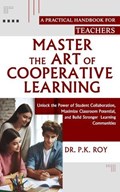Are you seeking ways to make your classroom more engaging, interactive, and interesting?
Do you want to delve into the intricacies of cooperative learning and its transformative impact on education?
Look no further—this book is your ultimate guide to mastering the art of cooperative learning.
Master the Art of Cooperative Learning is meticulously designed as a comprehensive resource, offering educators a clear blueprint for implementing cooperative learning strategies. This guide will aid you in fostering young learners' comprehension, tackling complex concepts, honing communication skills, nurturing collaboration, and ultimately achieving remarkable academic success.
Unveiling Proven Strategies
Inside this book, you will discover a treasure trove of proven Kagan Structures such as Think Pair Share, Numbered Heads Together, Jigsaw, and Three-Step Interview. These strategies are seamlessly integrated into lesson plans to enhance comprehension and engagement. Each structure is explained in detail, providing you with practical tools to transform your teaching methodology.
For instance, in the realm of Mathematics, cooperative learning can demystify complex concepts, making them more accessible and enjoyable through peer interaction and collaborative problem-solving.
In English education, cooperative learning strategies like literature circles and role-playing activities can significantly enhance language acquisition and critical thinking.
In Science education, cooperative learning promotes active engagement, teamwork, and a deeper understanding of scientific concepts. Through hands-on experiments and group discussions, students learn to collaborate effectively, develop critical thinking skills, and cultivate a genuine interest in scientific inquiry.
Similarly, in Social Sciences, cooperative learning fosters empathy, critical thinking, and intellectual inquiry. Structured activities and diverse group interactions encourage students to explore different perspectives, develop social skills, and engage in meaningful discussions about historical and contemporary issues.
Integrating Technology
A dedicated chapter explores the role of technology in enhancing cooperative learning. It provides an overview of various digital tools such as Google Docs, Zoom, Padlet, Microsoft Teams, Slack, Trello, Miro, Google Classroom, Kahoot, and more. Each tool is succinctly explained, showcasing how they can boost collaboration and engagement in virtual classrooms. Integrating these technologies ensures that cooperative learning stays relevant and effective in today's digital age.
Overcoming Challenges
The book also addresses common obstacles in cooperative learning, such as unequal participation and conflict resolution. Practical strategies are provided to tackle these challenges, ensuring effective and inclusive group work.
Additionally, the book offers an array of ***team-building and class-building activitie***s.
A Must-Have Resource
Every teacher should have this book on their shelf. It serves as an invaluable guide to cooperative learning strategies, providing you with the tools and insights needed to create an engaging and interactive classroom. Whether you are a seasoned educator or a new teacher, this book will empower you to implement cooperative learning effectively, enhancing your teaching practice and enriching your students' learning experiences. Embrace this approach, and watch your classroom become a vibrant hub of collaboration, creativity, and academic excellence.

